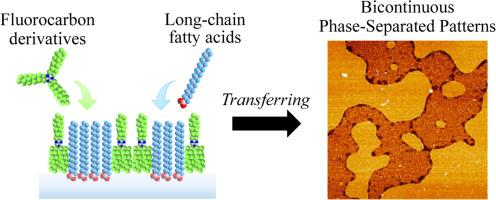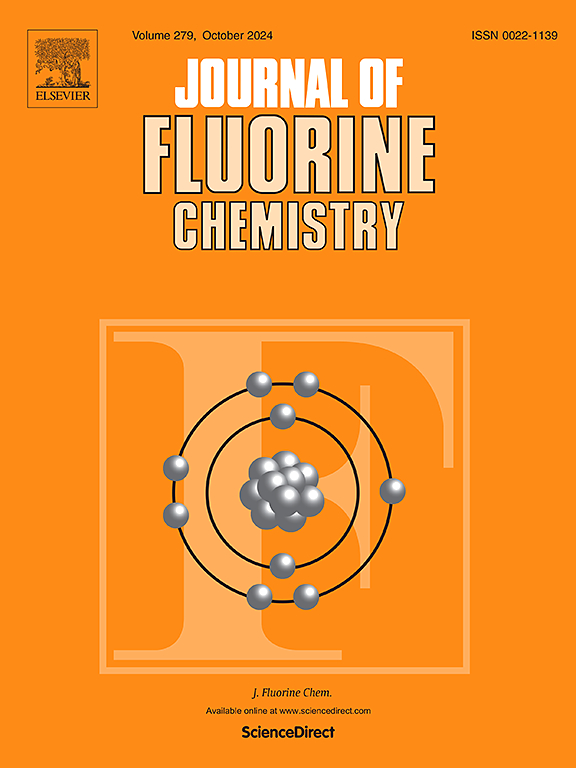通过使用带有三条氟化链的非亲和 s-三嗪衍生物制备混合单层,对双连续相分离图案进行形态学控制
IF 1.7
4区 化学
Q3 CHEMISTRY, INORGANIC & NUCLEAR
引用次数: 0
摘要
本研究讨论了无亲水基团的非亲水碳氟化合物衍生物与长链脂肪酸混合单层中双相分离的形态发生。这些碳氟化合物衍生物含有一个 s-三嗪环和三条碳氟化合物链。相应的碳氟化合物衍生物在单层中表现出很高的结晶度,即使在出现相分离的混合单层的 "海洋 "区域也能保持结晶的规整性。在控制双连续模式的过程中,研究人员考察了氟基衍生物和梳状聚合物混合体系中复杂相分离形态的形成,以及碳氢化合物/氟碳化合物混合体系中的高浓度和低扩散条件。结果表明,在低温(5 °C)条件下,缩聚相域呈角状,而在高温(40 °C)条件下,其表面接近于双连续特征。随着氢化凝聚畴的形成,碳氟化合物链的 "海洋 "区域失去了秩序。此时,纳米域的形状趋于圆形。本文章由计算机程序翻译,如有差异,请以英文原文为准。

Morphological control of bicontinuous phase-separated patterns by preparing mixed monolayers using non-amphiphilic s-triazine derivatives with three fluorinated chains
In this study, the morphogenesis of the bicontinuous phase separation in mixed monolayers of a non-amphiphilic fluorocarbon derivative without a hydrophilic group and long-chain fatty acids is discussed. These fluorocarbon derivatives contain an s-triazine ring and three fluorocarbon chains. The corresponding fluorocarbon derivatives exhibit high crystallinity in the monolayers, allowing them to maintain crystalline regularity even in the "sea" region of the mixed monolayer that exhibits phase separation. In controlling the bicontinuous pattern, the formation of complex phase-separated morphology in the mixed system of fluorine-based derivatives and comb polymers, along with the high concentration and low diffusion conditions in the mixed hydrocarbon/fluorocarbon system, were examined. It was observed that the condensed phase domains became angular shape at a low temperature (5 °C), and the surface approached a bicontinuous feature at a high temperature (40 °C). With the formation of hydrogenated condensed domains, the "sea" region of fluorocarbon chains lost its order. At this point, the shape of the nanodomains tended to become more circular.
求助全文
通过发布文献求助,成功后即可免费获取论文全文。
去求助
来源期刊

Journal of Fluorine Chemistry
化学-无机化学与核化学
CiteScore
3.80
自引率
10.50%
发文量
99
审稿时长
33 days
期刊介绍:
The Journal of Fluorine Chemistry contains reviews, original papers and short communications. The journal covers all aspects of pure and applied research on the chemistry as well as on the applications of fluorine, and of compounds or materials where fluorine exercises significant effects. This can include all chemistry research areas (inorganic, organic, organometallic, macromolecular and physical chemistry) but also includes papers on biological/biochemical related aspects of Fluorine chemistry as well as medicinal, agrochemical and pharmacological research. The Journal of Fluorine Chemistry also publishes environmental and industrial papers dealing with aspects of Fluorine chemistry on energy and material sciences. Preparative and physico-chemical investigations as well as theoretical, structural and mechanistic aspects are covered. The Journal, however, does not accept work of purely routine nature.
For reviews and special issues on particular topics of fluorine chemistry or from selected symposia, please contact the Regional Editors for further details.
 求助内容:
求助内容: 应助结果提醒方式:
应助结果提醒方式:


